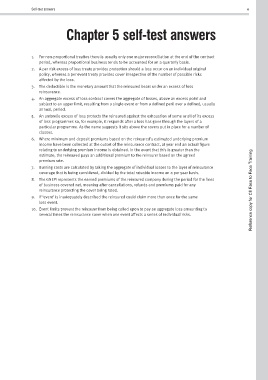Page 363 - M97TB9_2018-19_[low-res]_F2F_Neat2
P. 363
Self-test answers v
Chapter 5 self-test answers
1. For non-proportional treaties there is usually only one major reconciliation at the end of the contract
period, whereas proportional business tends to be accounted for on a quarterly basis.
2. A per risk excess of loss treaty provides protection should a loss occur on an individual original
policy, whereas a per event treaty provides cover irrespective of the number of possible risks
affected by the loss.
3. The deductible is the monetary amount that the reinsured bears under an excess of loss
reinsurance.
4. An aggregate excess of loss contract covers the aggregate of losses, above an excess point and
subject to an upper limit, resulting from a single event or from a defined peril over a defined, usually
annual, period.
5. An umbrella excess of loss protects the reinsured against the exhaustion of some or all of its excess
of loss programmes so, for example, it responds after a loss has gone through the layers of a
particular programme. As the name suggests it sits above the covers put in place for a number of
classes.
6. Where minimum and deposit premiums based on the reinsured’s estimated underlying premium
income have been collected at the outset of the reinsurance contract, at year end an actual figure
relating to underlying premium income is obtained. In the event that this is greater than the
estimate, the reinsured pays an additional premium to the reinsurer based on the agreed
premium rate.
7. Burning costs are calculated by taking the aggregate of individual losses to the layer of reinsurance
coverage that is being considered, divided by the total rateable income on a per year basis.
8. The GNEPI represents the earned premiums of the reinsured company during the period for the lines
of business covered net, meaning after cancellations, refunds and premiums paid for any
reinsurance protecting the cover being rated. Reference copy for CII Face to Face Training
9. If ‘event’ is inadequately described the reinsured could claim more than once for the same
loss event.
10. Event limits prevent the reinsurer from being called upon to pay an aggregate loss amounting to
several times the reinsurance cover when one event affects a series of individual risks.

